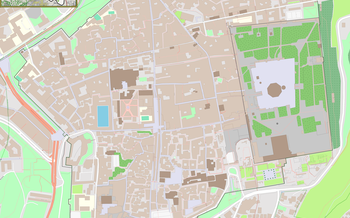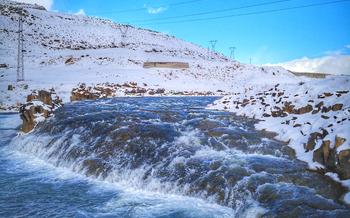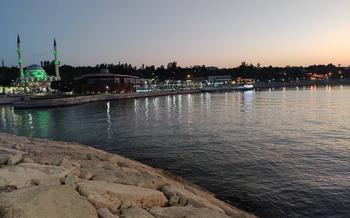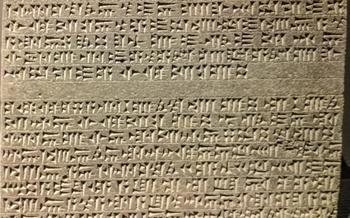
Kurubaş Inscriptions
- Historical Significance
- Location and Accessibility
- Visual Description
- Content and Meaning
- Historical Context
- Cultural Significance
- Tourism and Visitor Experience
- Conservation and Preservation
- Local Cuisine:
- Local Crafts and Handicrafts
- Nearby Attractions
- Accommodations
- Transportation
- Safety and Security
- Insider Tip:
Historical Significance
The Kurubaş Inscriptions, a collection of ancient engravings and carvings, stand as silent witnesses to the rich and storied past of the Van region in eastern Turkey. These inscriptions, etched into the rocky cliffs overlooking the shimmering Lake Van, offer a glimpse into the cultural heritage and historical tapestry of this captivating region.
The inscriptions, meticulously crafted in various languages and scripts, including Urartian cuneiform, Armenian, and Georgian, provide a tangible link to the region's diverse past. They recount tales of ancient civilizations, conquests, and alliances, offering valuable insights into the political and cultural landscape that shaped this corner of Anatolia.
Among the most notable inscriptions is a Urartian text dating back to the 8th century BC, which narrates the military campaigns of King Sarduri II, who expanded the Urartian kingdom's influence over vast territories. Another inscription, written in Armenian, commemorates the construction of a church in the 10th century AD, highlighting the region's significant Christian heritage.
The inscriptions at Kurubaş are not mere historical records; they are windows into the lives, beliefs, and artistic expressions of the people who once inhabited this land. They showcase the region's rich linguistic and cultural diversity, making them a treasure trove for historians, archaeologists, and anyone fascinated by the ancient world.
Location and Accessibility
The Kurubaş Inscriptions are situated in the Van province of eastern Turkey, approximately 30 kilometers northeast of the city of Van. To reach the inscriptions, visitors can take the D300 highway and follow the signs for the Van Kalesi (Van Castle). From the castle, it is a short drive or a scenic walk to the inscriptions, which are located on a hilltop overlooking the city.
Public transportation is also available, with buses departing from Van's central bus station (Otogar) to the nearby village of Kurubaş. From there, visitors can take a taxi or walk the remaining distance to the inscriptions.
The road conditions in the area are generally good, and the drive from Van to the inscriptions takes about 30 minutes. However, it is advisable to check the weather forecast before embarking on the journey, as the region can experience heavy snowfall during the winter months.
Visual Description
The Kurubaş Inscriptions, etched into the rocky cliffs overlooking the sparkling waters of Lake Van, stand as a testament to the region's rich history and cultural heritage. These ancient markings, believed to date back to the 8th century BC, captivate visitors with their intricate designs and enigmatic symbols.
The inscriptions, carved meticulously into the rock surface, showcase an array of geometric patterns, stylized human figures, and animal motifs. The dominant geometric design features a series of concentric circles, radiating outwards from a central point, resembling a celestial body or a mandala. Interspersed between these circles are various symbols, including stylized human figures with raised arms, animals such as horses and bulls, and enigmatic signs resembling stars or constellations.
The inscriptions' weathered appearance adds to their allure, hinting at the passage of time and the stories they hold. While the harsh elements have eroded some of the finer details, the overall composition remains remarkably well-preserved, a testament to the skill and artistry of their ancient creators. The inscriptions' rugged beauty, set against the backdrop of the serene lake and the majestic mountains, creates a visually captivating spectacle that leaves visitors in awe.
Content and Meaning
The Kurubaş Inscriptions are a treasure trove of historical and cultural information. The inscriptions are written in a mix of Old Persian, Elamite, and Babylonian cuneiform scripts, and they provide valuable insights into the political, religious, and economic life of the region during the Achaemenid period. The inscriptions mention several Achaemenid kings, including Darius I, Xerxes I, and Artaxerxes I, and they document their military campaigns, construction projects, and administrative reforms. The inscriptions also provide information about the local population, their customs, and their interactions with the Persian Empire.
One of the most fascinating aspects of the Kurubaş Inscriptions is their multilingual nature. The inscriptions are written in three different languages, which suggests that the Achaemenids were keen to communicate their messages to a wide audience. The use of multiple languages also reflects the cultural diversity of the Achaemenid Empire, which encompassed a vast territory stretching from India to Greece.
The Kurubaş Inscriptions have been the subject of extensive study by historians and archaeologists, and they continue to yield new insights into the ancient world. The inscriptions are a valuable source of information about the Achaemenid Empire, and they provide a glimpse into the lives of the people who lived during this remarkable period of history.
Historical Context
The Kurubaş Inscriptions stand as relics of a rich historical tapestry, deeply entwined with the region's past. The inscriptions emerged during the reign of the Urartian Kingdom, a powerful civilization that flourished in the ancient lands of Armenia from the 9th to the 6th century BC. The Urartians, known for their architectural prowess and military strength, left an indelible mark on the region, and the Kurubaş Inscriptions serve as a testament to their legacy.
These inscriptions offer a glimpse into the political and cultural landscape of the Urartian era. They commemorate the military victories and achievements of various Urartian kings, providing valuable insights into the kingdom's territorial expansion and its interactions with neighboring states. The inscriptions also shed light on the Urartians' religious beliefs, as they often invoke the protection and favor of their gods, particularly the chief deity Haldi.
By examining the context in which the Kurubaş Inscriptions were created, we can piece together a more comprehensive understanding of the Urartian civilization. They reveal the kingdom's military prowess, its religious beliefs, and its complex interactions with other regional powers. The inscriptions serve as a window into a bygone era, allowing us to glimpse the grandeur and influence of the Urartian Kingdom.
Cultural Significance
The Kurubaş Inscriptions hold immense cultural significance for the local community, serving as a tangible link to their rich history and heritage. They are revered as a symbol of the region's cultural identity and pride. The inscriptions have influenced local traditions, beliefs, and folklore, weaving them into the fabric of everyday life. Over time, the inscriptions have become a source of inspiration for local artists, writers, and musicians, who draw upon their symbolism and messages to create vibrant works of art, literature, and music. The local community actively participates in preserving and promoting the cultural heritage embodied by the Kurubaş Inscriptions, organizing events, festivals, and ceremonies that celebrate their enduring significance. These events provide a platform for cultural exchange, showcasing traditional dances, music, and storytelling that pay homage to the inscriptions and their enduring legacy.
Tourism and Visitor Experience
Visiting the Kurubaş Inscriptions offers a unique and enriching experience for history buffs, culture enthusiasts, and travelers seeking off-the-beaten-path destinations. To make the most of your visit, plan your trip during the spring or autumn months to avoid extreme weather conditions and crowds. The site features a visitor center that provides insightful information about the inscriptions and their historical significance. Guided tours are available, led by knowledgeable experts who can offer deeper insights into the inscriptions' content and context. While visiting, take the opportunity to immerse yourself in the local culture by sampling the delicious cuisine and exploring the vibrant markets where you can purchase handcrafted souvenirs and learn about traditional crafts. Combine your visit to the Kurubaş Inscriptions with other nearby attractions, such as the Van Fortress or the Akdamar Island, to create a comprehensive travel experience that showcases the region's rich history and cultural heritage.
Conservation and Preservation
The Kurubaş Inscriptions, as valuable historical artifacts, require diligent conservation and preservation efforts to ensure their longevity. Fortunately, there have been several initiatives undertaken to protect these inscriptions from the ravages of time and human activity. Local authorities and organizations have implemented strict regulations to prevent vandalism, unauthorized excavations, and the use of harmful chemicals or cleaning agents that could damage the inscriptions' delicate surfaces.
Regular monitoring and maintenance are conducted to assess the condition of the inscriptions and address any signs of deterioration. Conservation experts employ specialized techniques, such as laser cleaning and protective coatings, to minimize the effects of environmental factors like erosion, pollution, and weathering.
Furthermore, the promotion of responsible tourism plays a vital role in preserving the Kurubaş Inscriptions. Visitors are encouraged to adhere to designated pathways, refrain from touching or climbing on the inscriptions, and avoid using flash photography, which can harm the pigments and surfaces. By fostering a culture of respect and appreciation among tourists, the inscriptions' integrity can be maintained for generations to come.
Collaborative efforts between archaeologists, historians, and local communities are crucial for ensuring the continued preservation of the Kurubaş Inscriptions. Through ongoing research, documentation, and educational programs, the significance and value of these inscriptions can be communicated to a wider audience, inspiring future generations to safeguard this precious cultural heritage.
Local Cuisine:
The region where the Kurubaş Inscriptions reside is renowned for its rich culinary traditions, blending Turkish, Armenian, and Kurdish influences. Savor the flavors of freshly baked pide, a traditional flatbread stuffed with various fillings. Indulge in kelle paça, a hearty lamb head and foot soup, or lahmacun, a thin dough topped with minced meat, vegetables, and spices. Don't miss Van kahvaltısı, a lavish breakfast spread featuring regional delicacies like otlu peynir (herb-infused cheese), murtuğa (apricot jam), and bal kaymak (honey and clotted cream). For a sweet treat, try kadayıf dolması, crispy shredded pastry filled with walnuts and sweetened with syrup. Ayran, a refreshing yogurt drink, is a perfect accompaniment to any meal. Experience the warmth of Turkish hospitality as you dine at local restaurants or enjoy a home-cooked feast in a traditional Kurdish household.
Local Crafts and Handicrafts
The region near the Kurubaş Inscriptions is renowned for its vibrant tradition of crafts and handicrafts, showcasing the creativity and skill of local artisans. Visitors can explore the bustling bazaars or workshops to discover an array of handmade treasures. Among the popular crafts, handwoven rugs and kilims stand out with their intricate designs and vibrant colors, reflecting the region's rich nomadic heritage.
Another notable craft is the intricate art of silver filigree, where artisans meticulously craft delicate jewelry and ornaments using fine silver threads. Visitors can witness the artisans' deft hands as they transform silver into intricate masterpieces.
Pottery is another specialty of the region, with local craftsmen creating unique ceramics and earthenware using traditional techniques passed down through generations. These handcrafted items, often adorned with colorful glazes and intricate patterns, make for beautiful souvenirs or gifts.
For a truly immersive experience, visitors can participate in hands-on workshops and learn the art of carpet weaving, pottery, or silver filigree from local artisans. These workshops provide a unique opportunity to connect with the local culture and gain a deeper appreciation for the region's rich craftsmanship.
Nearby Attractions
Complementing your visit to the Kurubaş Inscriptions, the region offers a plethora of captivating attractions that further enrich the travel experience. Immerse yourself in the natural wonders of Lake Van, the largest lake in Turkey, renowned for its pristine waters, picturesque islands, and unique ecosystem. Explore the ancient Armenian monastery of Akdamar Island, a testament to the region's rich cultural heritage, situated amidst the serene lake waters. For history enthusiasts, the Van Museum is a treasure trove of artifacts and exhibits showcasing the region's past, from prehistoric times to the present day. Embark on a culinary adventure by savoring the delectable local cuisine, featuring mouthwatering dishes such as "Van Kahvaltısı" (Van breakfast) and "Murtuğa," a unique type of trout found only in Lake Van. Discover the vibrant local markets, brimming with colorful textiles, handmade crafts, and fresh produce, offering a glimpse into the region's vibrant traditions. Venture beyond the city to explore the natural beauty of the surrounding landscapes, including the stunning waterfalls of Muradiye and the lush greenery of the Nemrut Crater Lake.
Accommodations
When planning your trip to the Kurubaş Inscriptions, a range of accommodation options are available to suit various preferences and budgets. In the vicinity of the inscriptions, you'll find cozy guesthouses and charming homestays that offer a local touch and immersive experience. These accommodations often provide traditional Turkish hospitality, allowing you to connect with the local culture and enjoy authentic home-cooked meals.
For those seeking more modern amenities, several comfortable hotels are located within a short distance of the site. These hotels offer a range of facilities, including spacious rooms, restaurants, and convenient access to local attractions. Whether you prefer the warmth of a family-run guesthouse or the comfort of a modern hotel, you'll find suitable options to make your stay in the region enjoyable and memorable.
To ensure a hassle-free experience, it's advisable to book your accommodation in advance, especially during peak tourist seasons. Online booking platforms and local travel agencies can assist you in finding the best deals and availability. Additionally, consider factors such as proximity to the inscriptions, amenities, and budget when making your choice.
Transportation
Getting around the region of the Kurubaş Inscriptions is relatively easy, with a range of transportation options available. Public transportation is a convenient and affordable choice, with buses and trains connecting the major cities and towns in the area. Taxis are also readily available, offering a more flexible and comfortable option for those willing to pay a bit more. For those who prefer the freedom and flexibility of exploring at their own pace, renting a car is a great option. Several car rental agencies operate in the region, allowing visitors to choose from a variety of vehicles to suit their needs and budget.
Safety and Security
The region surrounding the Kurubaş Inscriptions is generally considered safe for travelers. However, as with any destination, it's essential to exercise basic safety precautions. Be aware of your surroundings, avoid walking alone at night, and keep your valuables secure. It's advisable to respect local customs and traditions to avoid misunderstandings or conflicts. When visiting the inscriptions, stay on designated paths and avoid touching or climbing on the ancient structures to preserve them for future generations. If you have any concerns or encounter any issues, don't hesitate to seek assistance from local authorities or your tour guide. By being mindful of your safety and respecting the local culture, you can ensure a safe and enjoyable visit to the Kurubaş Inscriptions.
Insider Tip:
For an unforgettable experience, consider visiting the Kurubaş Inscriptions during the annual "Kurubaş Festival." This vibrant celebration, held every August, brings the ancient inscriptions to life with traditional music, dance, and storytelling. Immerse yourself in the local culture as you witness artisans demonstrating ancient crafts, savor delicious regional cuisine, and engage with locals who share stories and legends passed down through generations. The festival offers a unique opportunity to connect with the rich heritage of the region and gain a deeper understanding of the Kurubaş Inscriptions' significance beyond their historical value.









